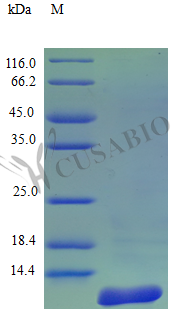Recombinant Human C-C motif chemokine 27 protein (CCL27) is produced in an E. coli expression system, spanning the full mature protein from amino acids 25 to 112. This tag-free protein maintains a high purity level of over 96% as verified by SDS-PAGE analysis. It displays significant biological activity, confirmed via a chemotaxis bioassay with CCR10 transfected BaF3 cells, within a concentration range of 10-100 ng/ml. The endotoxin level is controlled to less than 1.0 EU/µg, as determined by the LAL method.
CCL27 appears to function as a chemokine within the immune system's signaling networks. It likely plays a critical role in directing immune cell movement toward inflammation sites, particularly affecting skin tissue where it interacts with the receptor CCR10. Understanding CCL27 may be vital for researchers investigating immune response mechanisms and potential therapeutic targets in inflammatory conditions.
Potential Applications
Note: The applications listed below are based on what we know about this protein's biological functions, published research, and experience from experts in the field. However, we haven't fully tested all of these applications ourselves yet. We'd recommend running some preliminary tests first to make sure they work for your specific research goals.
1. CCR10 Receptor Binding and Signaling Studies
This recombinant CCL27 is confirmed to be biologically active through CCR10-mediated chemotaxis (10-100 ng/ml) and suitable for receptor binding and signaling studies. The defined activity range provides reliable parameters for dose-response experiments in CCR10-expressing systems. However, researchers should note that binding affinity (Kd) may differ from functional EC₅₀ values and should be determined empirically using appropriate binding assays. The tag-free design ensures accurate measurement of receptor interaction kinetics without potential tag interference.
2. Chemotaxis and Cell Migration Assays
The demonstrated chemotactic activity in CCR10-transfected BaF3 cells validates this protein for migration studies with CCR10-positive cells. However, researchers should validate optimal concentrations for primary cells (e.g., skin-homing T cells) as receptor density and signaling efficiency may differ from transfected cell lines. The high purity and low endotoxin ensure that observed migration is specifically attributable to CCL27-CCR10 interactions rather than non-specific stimulation.
3. Antibody Development and Validation
This high-purity, tag-free CCL27 serves as an excellent antigen for antibody development. The confirmed bioactivity indicates proper folding for conformational epitope presentation. However, researchers should validate that antibodies generated against this E. coli-expressed protein recognize native, mammalian-produced CCL27 in biological samples, as differences in post-translational modifications may affect antibody binding in some applications.
4. Protein-Protein Interaction Studies
The biologically active CCL27 is suitable for interaction studies with CCR10 and potential co-receptors. However, the relatively high active concentration range (10-100 ng/ml) may indicate moderate binding affinity, requiring sensitive detection methods for interaction assays. Any novel interactions identified should be validated in physiological systems to confirm biological relevance beyond the transfected cell model used for activity confirmation.
5. Structure-Function Relationship Analysis
This well-characterized CCL27 serves as an ideal reference standard for structure-function studies. The confirmed activity profile provides a reliable baseline for comparing engineered variants. However, researchers should note that E. coli expression produces a non-glycosylated protein, and any structural modifications should be evaluated in the context of potential differences from native CCL27's post-translational modification status.
Final Recommendation & Action Plan
This recombinant human CCL27 is a validated tool suitable for the proposed applications, with demonstrated specific bioactivity through CCR10. For immediate use, employ it within the 10-100 ng/ml range for CCR10-dependent assays, but perform concentration optimization for specific cell types. The tag-free, high-purity design makes it particularly valuable for binding studies and antibody development. While the E. coli expression system produces a non-glycosylated protein, the confirmed bioactivity indicates proper folding for core CCL27 functions. For critical applications requiring native post-translational modifications, validate key findings with mammalian-expressed CCL27. Always include appropriate controls (e.g., CCR10-negative cells) and consider that different cell systems may exhibit varying sensitivity to CCL28 stimulation.






